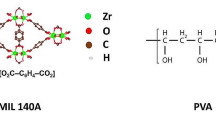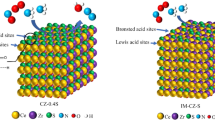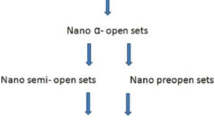Abstract
The methanol dehydrogenation reaction has been studied over impregnated copper-containing catalysts. A silica-montmorillonite nanocomposite has been used as the support for these systems. The catalyst’s features were found to depend strongly on the distance of the interlayer spacing within the structure of montmorillonite. The textural changes taking place in the support affect the accessibility of the active sites of the catalyst for methanol. The optimal temperature of the reductive pretreatment in hydrogen atmosphere required for the preparation of an active and durable enough nanocomposite-based catalyst was found to be 300°C.
Similar content being viewed by others
References
M. A. Vicente, M. A. Bañares-Muñoz, L. M. Gandia, and A. Gil, “On the structural changes of a saponite intercalated with various polycations upon thermal treatments,” Appl. Catal. A: General 217, 191–204 (2001).
S. Mnasri and N. Frini-Srasra, “Synthesis, characterization and catalytic evaluation of zirconia-pillared bentonite for 1,3-dioxalane synthesis,” Surf. Eng. Appl. Electrochem. 49(4), 336–347 (2013).
H. J. Chae, I.-S. Nam, S. W. Ham, and S. B. Hong, “Physicochemical characteristics of pillared interlayered clays,” Catal. Today 68, 31–40 (2001).
H. Mao, X. Liu, J. Yang, B. Li, Q. Chen, and J. Zhong, “Fabrication of magnetic silica-pillared clay (SPC) nanocomposites with ordered interlayer mesoporous structure for controlled drug release,” Microporous Mesoporous Mater. 184, 169–176 (2014).
H. Mao, K. Zhu, B. Li, C. Yao, and Y. Kong, “Synthesis of titania modified silica-pillared clay (SPC) with highly ordered interlayered mesoporous structure for removing toxic metal ion Cr(VI) from aqueous state,” Appl. Surf. Sci. 292, 1009–1019 (2014).
N. Wu, B. Li, Z. Liu, and C. Han, “Synthesis of Keggin-type lacunary 11-tungstophosphates encapsulated into mesoporous silica pillared in clay interlayer galleries and their catalytic performance in oxidative desulfurization,” Catal. Commun. 46, 156–160 (2014).
S. Mnasri-Ghnimi and N. Frini-Srasra, “Promoting effect of cerium on the characteristic and catalytic activity of Al, Zr, and Al-Zr pillared clay,” Appl. Clay Sci. 88–89, 214–220 (2014).
O. Yu. Golubeva, E. N. Korytkova, and V. V. Gusarov, “Hydrothermal synthesis of magnesium-silicate montmorillonite for polymeric-innorganic nanocomposites,” Zh. Prikl. Khim. 78(1), 26–33 (2005).
R. Jiang, W. Guo, M. Li, H. Zhu, L. Zhao, X. Lu, and H. Shan, “Methanol dehydrogenation on Rh(1 1 1): a density functional and microkinetic modeling study,” J. Molecu. Catal. A: Chem. 344, 99–110 (2011).
W. Guo, W. Q. Tian, X. Lian, F. Liu, M. Zhou, P. Xiao, and Y. Zhang, “A comparison of the dominant pathways for the methanol dehydrogenation to CO on Pt7 and Pt7 xNix (x = 1, 2, 3) bimetallic clusters: a DFT study,” Comput. Theor. Chem. 1032, 73–83 (2014).
S. Su, P. Zaza, and A. Renken, “Catalytic dehydrogenation of methanol to water-free formaldehyde,” Chem. Eng. Technol. 17(1), 34–40 (1994).
J. S. Lee, J. C. Kim, and Y. G. Kim, “Methyl formate as a new building block in C1 chemistry,” Appl. Catal. 57(1), 1–30 (1990).
E. V. Egorova, S. N. Antonyuk, A. I. Trusov, E. R. Nugmanov, and A. Yu. Gureeva, “Historical aspects of synthesis methods development for methylformate,” in Proc. Reaktiv-2002 (Reaktiv, Ufa, 2002), pp. 196–198.
I. Rodriguez-Ramos, A. Guerrero-Ruiz, M. L. Rojas, and J. L. G. Fierro, “Dehydrogenation of methanol to methyl formate over copper-containing perovskitetype oxides,” Appl. Catal. 68(1), 217–228 (1991).
A. Guerrero-Ruiz, I. Rodriguez-Ramos, and J. L. G. Fierro, “Dehydrogenation of methanol to methyl formate over supported copper catalysts,” Appl. Catal. 72(1), 119–137 (1991).
A. C. Lausche, F. Abild-Pedersen, R. J. Madix, J. K. Nørskov, and F. Studt, “Analysis of sulfur-induced selectivity changes for anhydrous methanol dehydrogenation on Ni(100) surfaces,” Surf. Sci. 613, 58–62 (2013).
T. Matsuda, K. Yogo, C. Pantawong, and E. Kikuchi, “Catalytic properties of copper-exchanged clays for the dehydrogenation of methanol to methyl formate,” Appl. Catal. A 126(1), 177–186 (1995).
Y. Morikawa, K. Takagi, Y. Moro-Oka, and T. Ikawa, “Cu-fluortetrasilica mica. A novel effective catalyst for the dehydrogenation of methanol to from methyl formate,” Chem. Lett., No. 11, 1805–1808 (1982).
Y. Morikawa, T. Goto, Y. Moro-Oka, and T. Ikawa, “Conversion of methanol over metal ion exchanged forms of fluorotetrasilica mica,” Chem. Lett., No. 10, 1667–1670 (1982).
Y. Morikawa, K. Takagi, Y. Moro-Oka, and T. Ikawa, “Dehydrogenation of methanol to form methyl formate over cupric ion exchanged form of fluorotetrasilica mica,” in Proc. 8th Int. Congr. on Catalysis (Berlin, 1984), Vol. 5, pp. V679–V690.
M. Frenkel, “Surface acidity of montmorillonites,” Clays Clay Miner. 22, 435–441 (1974).
E. D. Guerreiro, O. F. Gorriz, G. Larsen, and L. A. Arrúa, “Cu/SiO2 catalysts for methanol to methyl formate dehydrogenation: a comparative study using different preparation techniques,” Appl. Catal. A: General 204(1), 33–48 (2000).
D. I. Kochubei, EXAFS Spectroscopy for Catalysts (Nauka, Novosibirsk, 1992) [in Russian].
Author information
Authors and Affiliations
Corresponding author
Additional information
Original Russian Text © A.A. Vedyagin, A.I. Nizovskii, K.S. Golohvast, P.G. Tsyrulnikov, 2014, published in Rossiiskie Nanotekhnologii, 2014, Vol. 9, Nos. 11–12.
Rights and permissions
About this article
Cite this article
Vedyagin, A.A., Nizovskii, A.I., Golohvast, K.S. et al. Nanocomposites on the basis of layered silicates as the catalysts for the dehydrogenation of methanol. Nanotechnol Russia 9, 693–699 (2014). https://doi.org/10.1134/S1995078014060172
Received:
Accepted:
Published:
Issue Date:
DOI: https://doi.org/10.1134/S1995078014060172




